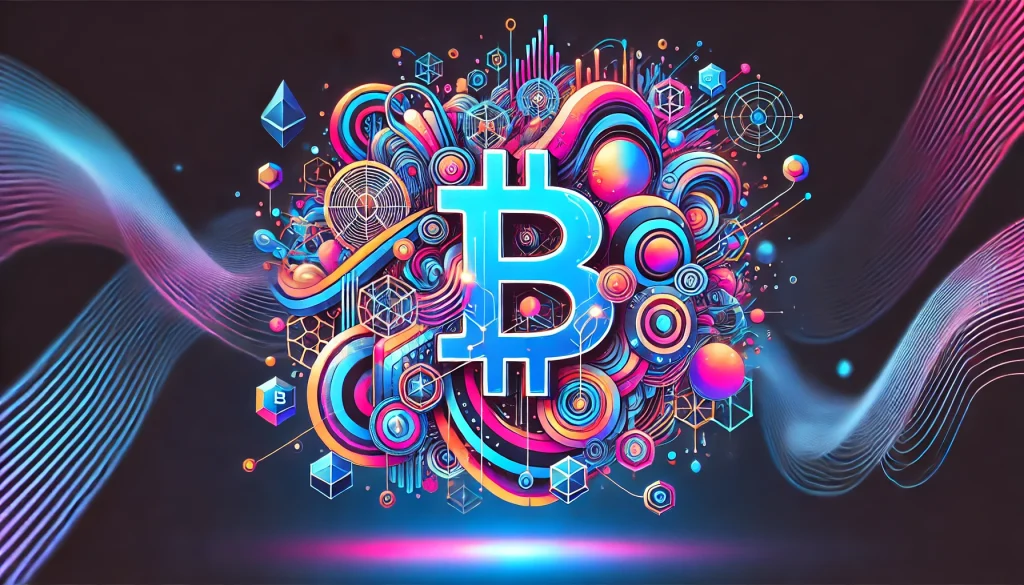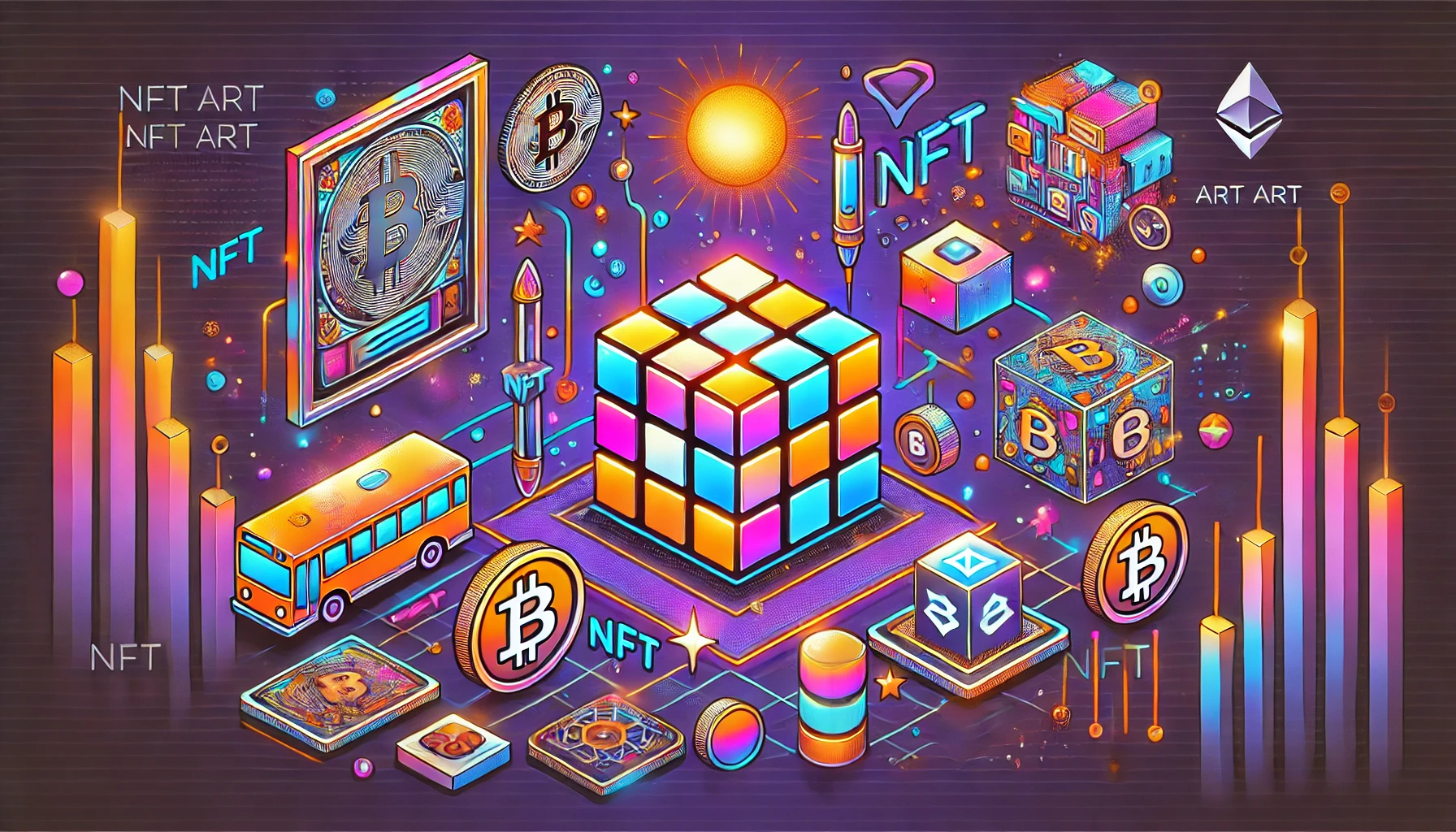The Rise of NFT Art: What You Need to Know About This Digital Revolution
Non-fungible tokens (NFTs) have quickly become a significant force in both the art and cryptocurrency worlds. Since their rise in popularity, NFT art has captured the attention of creators, collectors, and tech enthusiasts alike. But why has this combination of digital art and blockchain technology sparked such excitement? In this article, we’ll explore the rise of NFT art, its influence on the art world, and the most crucial aspects you need to know if you’re considering stepping into this groundbreaking space.
NFT Art?

NFT art refers to digital artwork that is tokenized using blockchain technology, making it unique and verifiable. NFTs are unlike traditional cryptocurrencies such as Bitcoin or Ethereum, which are “fungible” — meaning they are interchangeable. Instead, NFTs are non-fungible, meaning each one holds a distinct value and identity. This digital token provides proof of ownership, granting the artist or owner a way to ensure their creation is one-of-a-kind. Many platforms such as Opensea, a major Non-fungible token marketplace, allow creators to sell their works as NFTs, giving them control over pricing, royalties, and future sales.
NFT art spans a variety of mediums, including digital paintings, 3D models, animations, and even music. Famous NFT sales include everything from iconic memes to high-end art pieces from well-known creators. The digital art market was relatively niche until NFTs introduced a way for artists to monetize their digital works effectively.
A Closer Look at the NFT Art Explosion
NFTs have gained popularity in part because they offer an alternative for artists to distribute and profit from their work. Traditional art markets often rely on galleries and brokers, taking large commissions. NFTs bypass these intermediaries, allowing artists to sell directly to collectors and receive royalties from secondary sales. This shift has democratized the art world, opening doors for more creators to gain recognition without needing to navigate traditional art-world gatekeepers.
Artists who had previously struggled to monetize digital creations now have new avenues for revenue through NFTs. Furthermore, collectors are attracted by the opportunity to own exclusive digital works, adding to the sense of excitement surrounding this art form.
Why Is NFT Art So Popular?
The rise of NFT art can be attributed to several key factors. First, it offers digital ownership — a revolutionary concept in an age where most digital assets are easily copied or shared. Blockchain technology ensures that NFT art remains unique, with clear records of ownership and transaction history stored securely across decentralized networks. This has dramatically shifted the perception of digital artwork, transforming it into something rare and valuable.
Moreover, the surge in the cryptocurrency market has fueled interest in NFTs. Since NFTs are typically bought and sold using cryptocurrency, this asset class appeals to crypto investors looking for new ways to diversify their portfolios. For artists and creators, this presents a golden opportunity to tap into a new group of buyers eager to invest in unique digital pieces.
According to 99Designs in their article on NFT Art, the popularity of it marketplaces like Opensea has also played a significant role in expanding Non-fungible token awareness. These platforms provide a user-friendly space where anyone can create, buy, and sell NFTs, further lowering the barriers to entry for both artists and collectors.
What Makes NFT Art Valuable?
NFT art derives value from its scarcity, ownership, and provenance. While digital art can often be replicated, the ownership of an NFT provides the right to a unique version of that work. Additionally, the transparency of blockchain allows collectors to trace the ownership history of it, adding another layer of value. But what really makes an NFT valuable? Several factors contribute to its worth:
- Artist Reputation: Similar to traditional art, works from well-known digital artists or celebrities carry more weight in the marketplace.
- Scarcity: An NFT with only one or a limited number of editions is likely to be more valuable due to its rarity.
- Community: NFTs are often linked to a strong online community of collectors and creators, which adds social value.
- Utility: Some NFTs offer more than just ownership; they may provide perks, access to exclusive content, or interaction with the artist.
The Sotheby’s article on A Brief History of NFTs and Digital Art also highlights the importance of artistic innovation and how it ties into the success of Non-fungible token art. From virtual galleries to immersive 3D environments, artists are pushing the boundaries of what digital art can achieve.
Notable Examples of NFT Art Transforming the Digital Landscape
As the world of NFT art continues to grow, certain pieces and collections have stood out for their creativity, impact, and impressive sales. Here are three iconic examples of NFT art that have made headlines:
1. Beeple’s “Everydays: The First 5000 Days”

Beeple’s “Everydays: The First 5000 Days” became a historic moment in the NFT space when it was sold at Christie’s auction for $69.3 million in 2021. This digital collage consists of 5,000 unique images created by the artist over 13 years. It remains one of the most expensive NFT art sales and highlights the potential of digital art in mainstream markets.
2. CryptoPunks Collection

The CryptoPunks collection by Larva Labs is one of the earliest and most recognizable examples of NFT art. Featuring 10,000 algorithmically generated pixel art characters, these punks have become a symbol of the NFT movement, with individual CryptoPunks selling for millions. Their uniqueness and cultural significance have made them a staple in Non-fungible token history.
3. Pak’s “The Merge”
Pak, a renowned digital artist, created “The Merge,” an NFT art piece that was sold on the Nifty Gateway platform in December 2021 for $91.8 million. The artwork’s innovative format allowed multiple buyers to acquire “mass” tokens, which combined into a single entity over time. This interactive, evolving concept sets it apart in the world of NFT art.
What You Need to Know About NFT Art
NFT art isn’t just a fleeting trend—it’s reshaping how we think about ownership, art, and technology. If you’re considering diving into the world of NFT art, there are a few essential things you need to know:
- How It All Started: NFTs began gaining attention in 2017 with the launch of CryptoKitties, a blockchain game where users could buy, sell, and breed unique digital cats. Since then, the concept of tokenizing assets has expanded to include a wide array of digital art, music, and even real estate.
- The Benefits: For artists, NFTs provide an opportunity to reach a broader audience, set their own prices, and retain control over how their work is sold and resold. Through blockchain technology, artists can also earn royalties every time their Non-fungible token art is sold on secondary markets, creating a passive income stream.
- The Environmental Impact: NFTs aren’t without their critics. One significant concern is the energy consumption involved in blockchain transactions, particularly on networks like Ethereum. However, with new initiatives to reduce the environmental footprint of blockchain technology, many believe that the NFT space will continue to evolve toward greener solutions.
- Legal Considerations: Owning an Non-fungible token doesn’t always mean you own the copyright to the artwork. Depending on the terms set by the artist, buyers may only acquire the right to display or resell the tokenized work. Understanding these terms is crucial for any NFT buyer.
- Security: Like any digital asset, NFTs are stored in cryptocurrency wallets. Ensuring you have a secure wallet and keeping track of your private keys is essential to avoid losing access to your NFT collection.
New Features in the NFT Art Space
The Non-fungible token art world is constantly evolving, with new features and tools being developed to enhance the experience for both creators and collectors. Here are five exciting developments that are shaping the future of NFT art:
- Fractional Ownership: This allows collectors to buy a “share” of an expensive Non-fungible token, much like owning a fraction of a company’s stock.
- Dynamic NFTs: These NFTs can change over time, reacting to external data sources or user interactions. This could mean an artwork evolves based on specific inputs, offering a unique, ever-changing experience.
- Cross-Chain Interoperability: As more blockchains emerge, the ability to move NFTs between different blockchain networks will increase the liquidity and flexibility of the market.
- AR and VR Integration: Augmented reality (AR) and virtual reality (VR) are becoming more prominent in the NFT art space, allowing users to experience digital art in immersive environments.
- Social Tokens: These are NFTs that grant access to exclusive content or experiences with the artist, further blurring the lines between art and interaction.
Conclusion
NFT art is revolutionizing the creative world by offering artists new ways to monetize their work while giving collectors a stake in the future of digital art. The combination of blockchain technology, digital ownership, and limitless creative possibilities ensures that NFTs are here to stay. Whether you’re an artist or collector, now is the perfect time to explore the exciting world of NFT art and witness firsthand the potential it holds for the future.
FAQ
What is NFT art in the cryptocurrency space?
NFT art is a type of digital artwork that is bought and sold as a non-fungible token (NFT), a unique asset secured by blockchain technology. Unlike traditional art, these tokens allow for clear ownership records and monetization of digital art.
How does NFT art benefit creators and collectors?
NFT art provides artists with the ability to sell directly to collectors and earn royalties on secondary sales. For collectors, it offers an opportunity to own unique digital art and invest in the growing cryptocurrency space.
What is Opensea, and why is it important in the NFT art world?
Opensea is one of the largest NFT marketplaces where creators can mint, list, and sell their NFT art. It has played a significant role in expanding the reach of NFT art to a global audience.
Resources
- 99designs. NFT Art: What It Is, How It Works and How to Make It
- The Guardian. How NFTs (Non-fungible Tokens) Are Shaking Up the Art World
- Sotheby’s. A Brief History of NFTs and Digital Art
- Artory. The Top 13 Digital Art NFT Lots of 2021
- X (formerly Twitter). NFT Art Tweet by ArtistDutchArt

